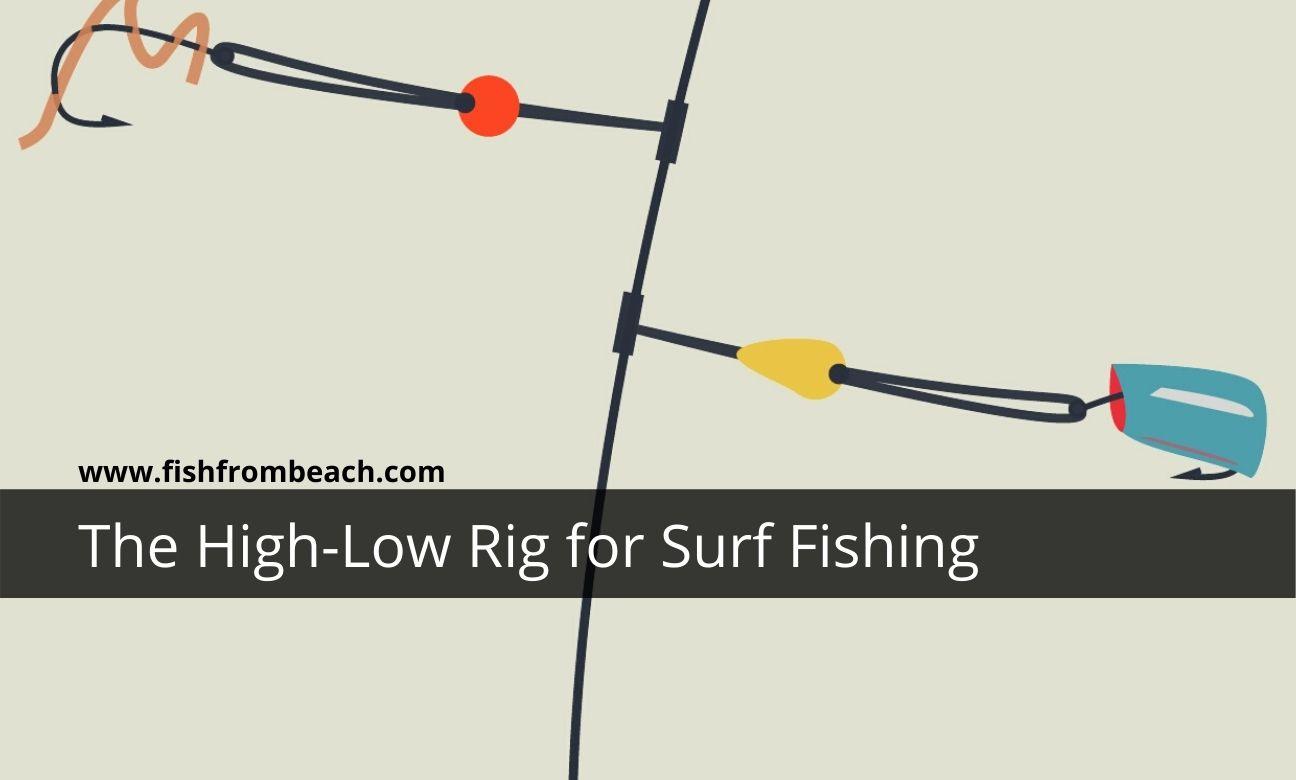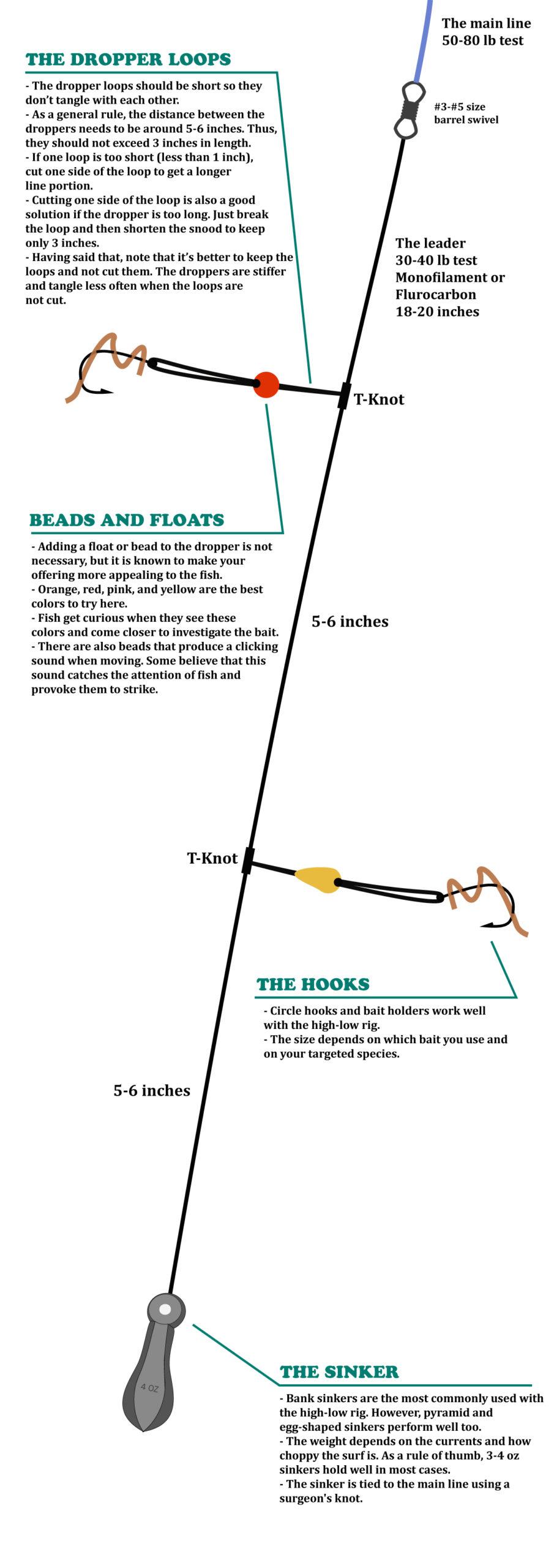The high-low rig is among the most famous line setups for surf fishing.
By allowing to use two baits at once, this rig is a favorite for many anglers who want to double their chances on the beach.
Moreover, fishermen do not like the high-low rig just because it results in more catches, but also because with two hooks in the surf, it makes the rods shake more often resulting in more dopamine spikes, and as a result, reinforcing the fishing addiction 😀
Now, with that said, the high-low rig is quite difficult to set-up compared to other rigs, especially for beginners who are still learning how to connect fishing equipment and tie knots.
That’s why I decided to write this article.
In the following lines, we will discuss the strengths and disadvantages of the high-low rig for surf fishing. How to set it up properly? And what are the conditions under which we should/shouldn’t use this rig?
So without further ado, let’s dive in.
How to set the high-low rig for surf fishing?
The first thing to start with when setting the high/low rig is the leader. The leader is the core of the rig and therefore should be chosen carefully depending on your fishing conditions.
Typically, you can use either monofilament or braid for the leader. However, monofilament is generally the best way to go for one simple reason: It’s thicker and therefore makes it easier to tie the dropper loops.
Also, monofilament is good abrasion resistant and therefore protects the rig from sharp-toothed fish.
For the size, the 30-40 lb test range works well in most conditions. As we said, the size of the leader depends not only on the species you are targeting, but also because we want some thickness to create the droppers easily.
Use a size #3-#5 barrel swivel to connect the leader to the main line, but before you do that, start by making the dropper loops first so you can get the distances right between the swivel, the droppers, and the sinker.
What are the dropper loops? Well, they are simply loops that we create at a right angle (90°) of the leader line, forming a T-shaped knot.
To make one, simply create a loop with the leader and then use one tag end to make 3-4 overhand knots in and out of the loop, and then take the other tag end and repeat the same process.
You want to create a small hole between the twists that you have created with the two tag ends.
Now take the head of the loop and insert it into the hole. Make sure the entire loop is inside and then slowly pull off the two tag ends.
I know, I am terrible at explaining such things, so I invite you to visit this decent tutorial from animatedknot.com. The guys there made splendid work explaining how to tie the T-knots and dropper loops efficiently.
One thing to keep in mind here is that the size of the dropper loop is dictated by the size of the initial loop.
In other words, the bigger the initial loop, the longer your dropper will be.
As a rule of thumb, the two droppers should not be able to tangle with each other and need to be 5 to 6 inches apart. Therefore, keep them at 3 inches long max.
Now what to do if you get a longer dropper? Well, simply trim on side of the loop and then shorten the obtained snood to 3 inches.
Similarly, if the droppers you made are too short (less than 1 inch), cut one side to get a longer snood.
After you tie the dropper loops, it’s time to connect the hooks.
Circle hooks are the best way to go here. The high/low rig incorporates a fixed weight and therefore requires fast hooksets to catch the fish before they feel the resistance of the weight.
With circle hooks, you don’t need to worry about that. Why? Simply because their design makes them penetrate fish’s mouths with no need to set the hook from the angler.
For the size, it all depends on the species you are targeting and the bait you use.
Here are two tables to help you choose a good hook size depending on the species and baits you use.
Hook size per bait type
| Bait Type | Hook Size |
|---|---|
| Nightcrawlers | 1/0 - 5/0 |
| Waxworms | #4 - #1 |
| Lugworms | 1/0 - 4/0 |
| Minnows | #2 - 2/0 |
| Squid | 2/0 - 4/0 |
| Shrimp | 1/0 - 3/0 |
| Crabs | #1 - 4/0 |
| Shellfish | #1 - 4/0 |
| Herring | 1/0 - 6/0 |
| Pilchard | 1/0 - 6/0 |
| Mackerel | 1/0 - 6/0 |
Hook size per fish species
| Fish Species | Hook Size |
|---|---|
| Whiting | #2 - 1/0 |
| Spanish Mackerel | 2/0 - 3/0 |
| Flounder | 2/0 – 3/0 |
| Bream | #4 - #1 |
| Porgy | #4 - #1 |
| Surfperch | #4 - #2 |
| Sea trout | 1/0 - 2/0 |
| Pompano | #1 - 2/0 |
| Blackfish | 2/0 - 3/0 |
| Redfish | 8/0 - 10/0 |
| Bluefish | 3/0 - 5/0 |
| Stripped bass | 7/0 - 9/0 |
| Tarpon | 4/0 - 8/0 |
| Red snapper | 5/0 - 7/0 |
| Codfish | 4/0 - 6/0 |
| Sharks | 7/0 - 10/0 |
Before connecting the hooks, it’s possible to add a bead or float for each dropper loop. I mean, they are not necessary, but many anglers swear by them and believe they add more appeal to the bait presentation and result in more catches.
Simply thread a 4-8 mm bead or pop-up into the dropper and then tie the hooks. Don’t worry about the beads being able to slide along the loop. The movement makes them more interesting to the fish, especially if they produce a clicking sound in the process.
The last thing is to tie the sinker.
Bank sinkers are the most common choice here. The size is dictated by the current and how agitated the surf is.
In general, 3-4 oz sinkers work well in most surf conditions.
To tie the bank sinker, simply create a surgeon’s knot and then connect the lead.
The picture below summarizes all we have said in this section with a few more details.
The advantages of the high-low rig
As we said, the major advantage of the high-low rig is that it allows you to cast two baits at a time and therefore improves your chances of getting a bite.
Think of it this way. Let’s assume that your average cast count on a normal fishing day is 20. Well, the high-low rig will double this number for you and allow you to cast 20 times more. It’s like fishing for two days instead of one.
The outcome of this is obvious: More bites and more trophies.
This gets a lot more interesting when aiming for species that move in schools such as pompano, sheepshead, herring, and whiting.
With an appetizing and well-presented bait, these species can give you a lot of happy double-catches.
I know, a single hook can outperform a double-hook configuration in certain conditions. But I am here talking from a mathematical perspective where productivity relies solely on how many times we cast the line.
Another advantage of the high-low rig is that it allows you to try different baits at a time. This is a good thing to have, especially when the fish in the surf have different diets and preferences.
Moreover, having the luxury to test different baits in one cast will allow you to figure out what brings the most results quickly and therefore tweak your offering in that direction.
With a single-hook rig, the process of optimizing your bait will be slower and you may lose a lot of time using things that are not interesting to the fish.
Another big benefit of using the high-low rig for surf fishing is to be able to target two depths in the water body simultaneously.
This allows you to target more species with different feeding habits.
The higher hook is suitable for the fish that prefer food to be slightly suspended off the bottom, and the second hook targets the bottom feeders looking for meals on the seabed.
The high-low rig also provides a decent bait presentation that encourages fish to strike.
For instance, the colorful beads and floats we add to this rig help to draw the attention of fish and bring them closer to investigate your offer.
You can go an extra mile here and look for beads that produce a clicking sound when moving. Many anglers claim that this sound provokes the fish and makes them want your bait.
The way this rig suspends baits in the water body is also very attractive to the fish. I mean, suspending hooks like that mimics the behavior of wounded baitfish and the crustaceans crawling on the seabed. Nothing is more tempting for predatory fish.
Just make sure your baits are looking good and enjoy the prolific combination: appetizing bait + moving bait.
The disadvantages of the high-low rig
The high-low rig is not suitable for all surf fishing objectives and conditions. With all the advantages it provides, there are some situations where it may not be the best way to go.
The most obvious drawback of the high-low rig is that it’s a little hard to set up and requires some time to get it cast-ready.
I mean, with 4 knots, two hooks, two droppers, a float, a bead, a leader, and a sinker, it’s pretty challenging for novice anglers to set everything properly in a short period of time.
This slight complication also makes the rig a bad choice in situations where we need a long casting distance or when fishing strong currents.
Let me elaborate.
With two droppers popping out of the rig body, this rig receives more frictions from the air during the cast and as a result, the terminal tackle drops sooner in the water.
For the same reason, the high-low rig receives more pressure from strong currents and therefore fails to keep your offer in the strike zone where the interesting things happen.
In other words, a choppy surf is likely to keep drifting the high-low rig out of where fish hold, resulting in a reduced catch count.
Worth noting also that the high-low rig gets snagged more often when fishing mixed seabeds rich in rock piles and seaweed. There are simply too many things attached to the rig which makes it more prone to tangle on surrounding objects.
In these conditions, a minimalistic line configuration that incorporates fewer items should provide a better casting distance, more stability in the surf, and lower snag risk.
The fish finder rig or Carolina rig are two good examples of that.
Another big weakness of the high-low rig is that it incorporates a fixed weight.
Why is this inconvenient?
Well, because when fish strikes a rig with a fixed weight, they feel the resistance of the sinker too quickly and as a result drop the bait before they get caught.
Conversely, when the sinker is able to slide and move along the line, it gives the fish more time to work the bait and completely swallow it before they feel any resistance.
This results in a better hookup ratio as fish cannot feel the trap until it’s too late.
This explains why surf anglers prefer to use small chunks of bait with the high-low rig. They want fish to be able to take the whole bait at once before they feel any threat.
This is actually another pitfall of the high-low rig. You can’t use large baits with it and therefore your offering is likely to be more attractive for smaller, tight-mouthed species.
Sizeable fish prefer larger meals, which is difficult to provide when the sinker cannot move and the hooks are only 5-6 inches apart.
Note (*): If you make a purchase through links from this website, we may get a small share of the sale from Amazon or other similar affiliate programs.
Surf Fishing Survey
Help us provide you with better content by answering simple questions about your surf fishing experience and knowledge.
We will put the collected responses together and turn them into valuable information that will help you catch more fish from shore 😉
Note: No personal information will be collected with your answer.



